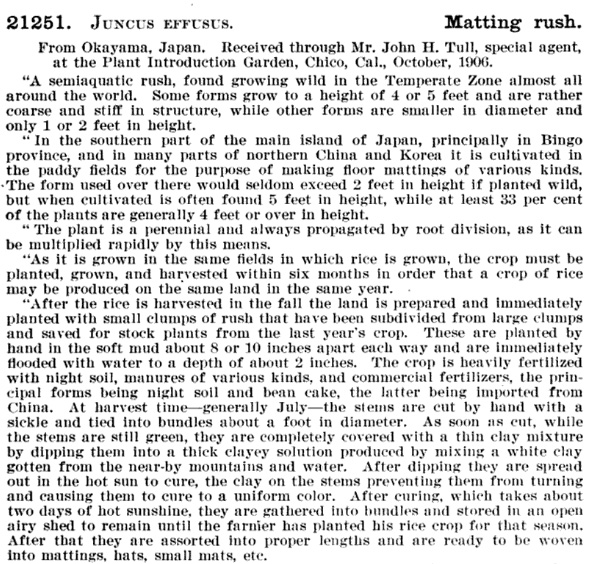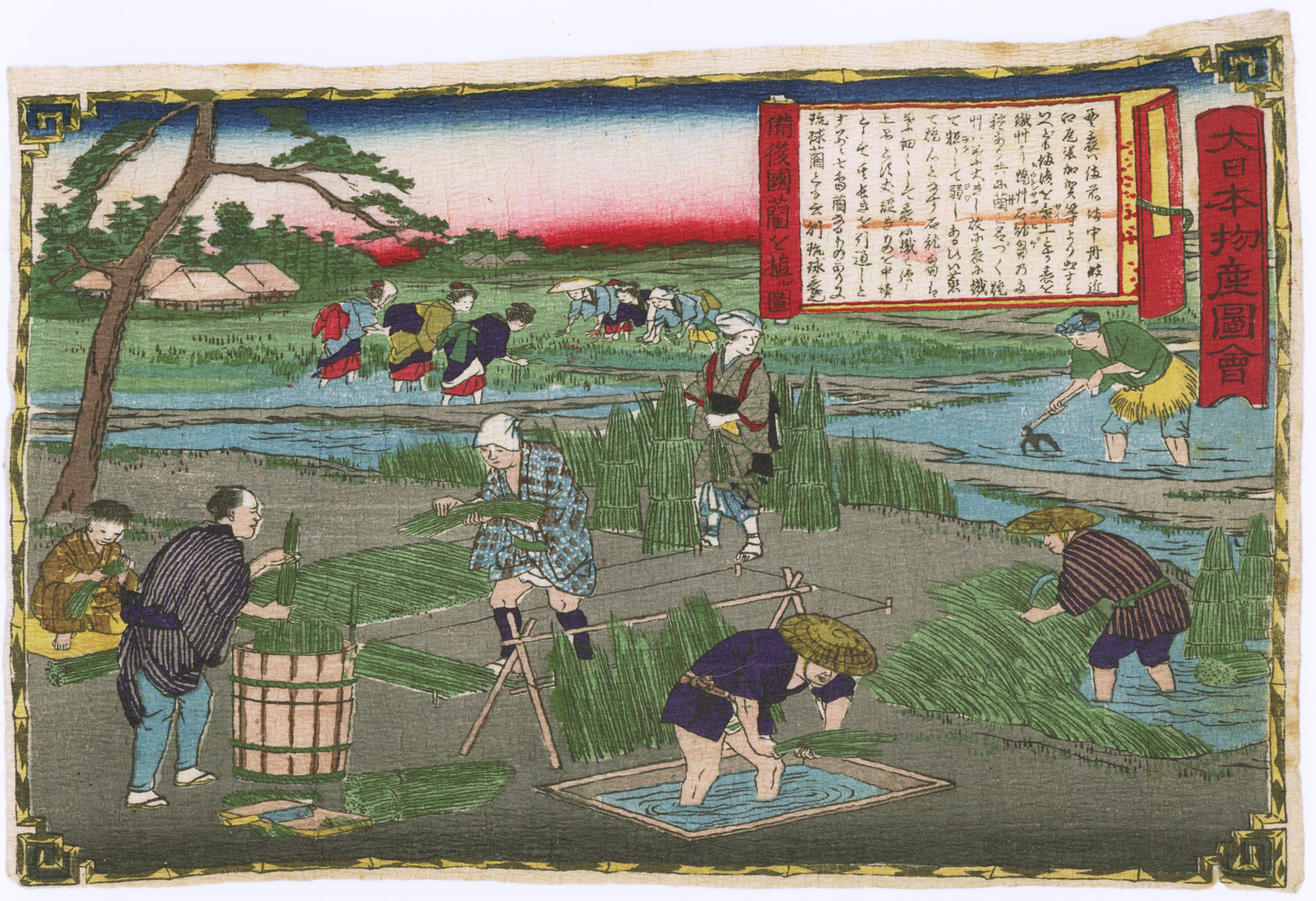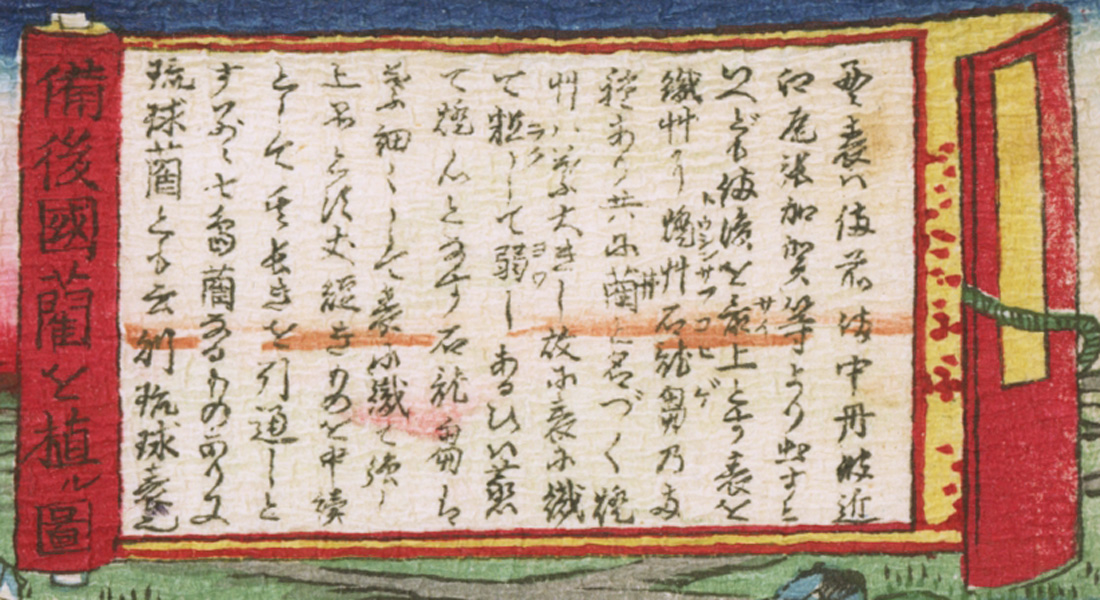About This Print
One of 118 prints in the series Dai Nippon Bussan Zue (Products of Greater Japan), issued in August 1877 to coincide with the opening of Japan’s first National Industrial Exposition (Naikoku Kangyō Hakurankai) held in Tokyo’s Ueno Park. It depicts the planting of rush (igusa) in Bingo Province (備後国, Bingo no kuni) which is now part of Hiroshima Prefecture.
Bingo Province (備後国 Bingo no kuni) was a province of Japan on the Inland Sea side of western Honshū, comprising what is today the eastern part of Hiroshima Prefecture. It was sometimes called Bishū (備州), with Bizen and Bitchu Provinces. Bingo bordered Bitchū, Hōki, Izumo, Iwami, and Aki Provinces.1
The crêped version of the print, IHL Cat. #1920, was made by the chirimen process, resulting in a cloth-like, smaller dimensioned, irregularly shaped print. (See the explanation in the Glossary under chirimen-e ("crêped" print)).Rush would be used for making tatami mats. (See IHL Cat. #461 Mat Making in Bingo Province.)
History of Rush (Igusa)
Source: "Igusa: A Critical Cash Crop in the Rural Economy of Okayama Prefecture" appearing in Economic Geography, Vol. 34, No. 1 (Jan., 1958), Taylor & Francis, Ltd., p. 47-63.
Rushes were used as floor coverings in Egypt, Medieval Europe, and other parts of the world but eventually were discarded for other types of floor covering. Not only has the rush been retained in Japan, but the making of mats from rushes has been developed into a relatively high art.
Prior to the Tokugawa Period, floor coverings were made from various materials. The usual ones were rice straw or shichitoi. Early in the Tokugawa Period the upper classes began using igusa which may have been introduced from India by way of China and Okinawa. The mats were earlier known as Bingo omote because the first center of igusa production was in the province of Bingo, now part of Hiroshima prefecture. However, igusa cultivation soon spread eastward to the provinces of Bichu and Bizen, now part of Okayama Prefecture. During the early Meiji Period the use of igusa became common among all classes, and today [1958] it is the chief floor covering used in Japan.
Planting Rush
Source: "Seeds and Plants Imported During the Period From July, 1906, to December 31, 1907", appearing in U.S. Department of Agriculture Bureau of Plant Industry - Bulletin No. 132, B. T. Galloway, 1908, p. 145.

Transcription of Scroll
-coming-
Multiple Editions (Variant Printings)
At least three variant printings (editions) were made of this series. Each variant printing uses a different colored cartouche containing the series' title, either red, green or rainbow-colored. Different colored borders were also used and variances in the use of colors and shading are present in the three editions. A crêped version of the series was also produced.
| IHL Catalog | #1920 |
| Title or Description | Planting Rush in Bingo Province 備後国藺を植ル図 |
| Series | Dai Nippon Bussan Zue 大日本物産図会 (Products of Greater Japan) |
| Artist | Utagawa Hiroshige III (1842–1894) |
| Signature | Artist's family name, Andō Tokubei, trimmed from the margin of this print. |
| Seal | none |
| Publication Date | 1877 (Meiji 10) |
| Publisher | Publishing information trimmed from the margin of this print. Ōkura Magobei 大倉孫兵衛 (Kin'eido; 1843-1921) [Marks: pub. ref. 627] |
| Impression | excellent |
| Colors | excellent |
| Condition | good - margins trimmed almost to image, normal misshapen size due to chirimen process |
| Genre | nishiki-e; kaika-e |
| Miscellaneous | |
| Format | chuban |
| H x W Paper | 5 9/16 x 8 1/8 in. (14.1 x 20.6 cm) |
| H x W Image | 5 3/8 x 7 15/16 in. ( 13.7 x 20.2 cm) |
| Literature | |
| Collections This Print | |
9/26/18



